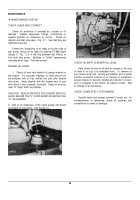TM-5-3805-254-14-P-1 - Page 46 of 590
MAINTENANCE
its use is not immediately forthcoming, special
precautions should be taken to prevent rust.
Contact the nearest Cummins Distributor for information
concerning engine storage procedures.
LUBRICATION AND FUEL
LUBRICATING OIL
Lubricating oil is used in Cummins engines to
lubricate moving parts, provide internal cooling and keep
the engine clean by suspending contaminants until
removed by the oil filters.
Lubricating oil also acts as a combustion seal and
protects internal parts from rust and corrosion.
The use of quality lubricating oil, combined with
appropriate lubricating oil, drain and filter change
intervals, is an important factor in extending engine life.
Cummins Engine Company, Inc.
does not recommend
any specific brand of lubricating oil.
The responsibility
for meeting the specifications, quality and performance
of lubricating oils must necessarily rest with the oil
supplier.
TABLE 3-1:
OIL RECOMMENDATIONS
LIGHT SERVICE ONLY
NATURALLY
(STOP-AND-GO)
ASPIRATED
ALL DIESEL MODELS
DIESEL MODELS
AP1 Class CC/SC
2/5
AP1 Class CC
1
1.85% Maximum
1.85% Maximum
Sulfated Ash Content
3
Sulfated Ash Content
3
TURBOCHARGED
ALL NATURAL
DIESEL
GAS MODELS
MODELS
ALL SERVICE
AP1 Class CC/CD 2
AP1 Class CC
1.85% Maximum
03 to .85%
Sulfated Ash Content
3
Sulfated Ash Content 4
1.
AP1 classification CC and CD quality oils as
used in turbocharged engines and AP1 classification
CC/SC quality oils as used for stop-and-go service are
satisfactory for use in naturally aspirated engines.
2.
AP1 classification CC/SC and CC/CD indicate
that the oil must be blended to the quality level required
by both specifications.
The range of oil quality permitted
by the CC classification is so broad that some oils that
meet the classification will not provide adequate
protection (varnish and ring sticking) for engines
operated in certain applications.
For example,
turbocharged engines require the additional protection
provided by the CD classification.
Engines operated in
stop and go service require the additional protection
provided by the SC classification.
3.
A sulfated ash limit has been placed on all
lubricating oils for Cummins engines because past
experience has shown that high ash oils may produce
harmful deposits on valves that can progress to guttering
and valve burning.
4.
Completely ashless oils or high ash content oils,
are not recommended for use in gas engines; a range of
ash content is specified.
5.
SD or SE may be substituted for SC.
BREAK IN OILS
Special
"Break-In"
lubricating
oils
are
not
recommended for new or rebuilt Cummins Engines.
Use
the same lubricating oil as will be used for the normal
engine operation.
VISCOSITY RECOMMENDATIONS
1.
Multigraded lubricating oils may be used in
applications
with
wide
variations
in
ambient
temperatures if they meet the appropriate performance
specifications and ash content limits shown in Table 3-1.
Multigraded oils are generally produced by adding
viscosity index improver additives to a low viscosity base
stock
to
retard
thinning
effects
at
operating
temperatures.
Poor quality multigraded oils use a
viscosity index improver additive which has a tendency
to lose its effectiveness after a short period of use in a
high speed engine.
These oils should be avoided.
2.
Oils which meet the low temperature SAE
viscosity standard (O deg F (-18 deg C) carry a suffix
"W".
Oils that meet the high temperature viscosity SAE
standard 210 deg F (99 deg C) as well as the low
temperature carry both viscosity ratings example 20-
20W.
See Table 3-2.
TABLE 3-2:
OPERATING TEMPERATURES VS VISCOSITY
AMBIENT TEMPERATURES
VISCOSITY
-10 deg.
F (-23 deg.
C) and
See Table 3-3.
below
-10 to 30 deg.
F (-23 to
10W
-1 deg.
C)
20 to 60 deg.
F (-7 to
20-20W
16 deg.
C)
40 deg.
F (4 deg.
C) and
30
above
40
Back to Top




















